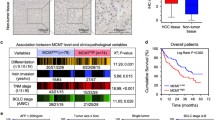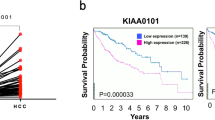Abstract
Background
Genomic instability is a common feature in hepatocellular carcinoma. Deregulation of replication licensing factors has been shown to trigger DNA damage response contributing to genomic instability. Overexpression of DNA replication licensing factors chromatin licensing and DNA replication factor 1 (CDT1) and minichromosome maintenance complex component 7 (MCM7) has been previously reported in several human cancers. The aim of the present study was to evaluate the expression and prognostic significance of CDT1 and MCM7 in association with DNA damage response markers and p53 in patients with hepatocellular carcinoma.
Methods
Expression of CDT1, MCM7, p-H2A histone family member X (H2AX), phospho-ataxia telangiectasia-mutated (ATM)/ataxia telangiectasia rad3-related (ATR) substrate, and p53 was evaluated by immunohistochemistry on formalin-fixed paraffin-embedded surgical specimens from 111 patients who underwent hepatectomy for hepatocellular carcinoma. Statistical analysis was performed to evaluate associations between the studied proteins, clinicopathological parameters, and patient survival.
Results
CDT1 expression correlated with p-H2AX (p = 0.038), while MCM7 correlated with p-H2AX and phospho-ATM/ATR substrate (p < 0.001). Increased CDT1 expression was associated with higher tumor grade (p = 0.006) and tumor-node-metastasis (TNM) stage (p = 0.033). High CDT1 expression correlated significantly with reduced overall survival (60.8 and 26.5 % vs 82.8 and 53.0 %, for low CDT1 expression, at 2 and 5 years, respectively, p = 0.012) and was identified by multivariate analysis as an independent predictor of poor overall survival (p = 0.049).
Conclusions
Overexpression of CDT1 and MCM7 in hepatocellular carcinoma correlates with DNA damage response, and CDT1 overexpression is a significant prognostic biomarker in hepatocellular carcinoma.






Similar content being viewed by others
Abbreviations
- HCC:
-
Hepatocellular carcinoma
- RLF:
-
Replication licensing factors
- DDR:
-
DNA damage response
- CDT1:
-
Chromatin licensing and DNA replication factor 1
- MCM7:
-
Minichromosome maintenance complex component 7
- H2AX:
-
H2A histone family member X
- ATM:
-
Ataxia telangiectasia-mutated
- ATR:
-
Ataxia telangiectasia rad3-related
- TNM:
-
Tumor-node-metastasis
- DSB:
-
Double-strand breaks
- ORC:
-
Origin recognition complex
- HBV:
-
Hepatitis B virus
- HCV:
-
Hepatitis C virus
- H-score:
-
Histoscore
- ROC:
-
Receiver operating characteristics
- AUC:
-
Area under ROC curve
- IQR:
-
Interquartile range
References
Colombo M, Raoul JL, Lencioni R, Galle PR, Zucman-Rossi J, Bañares R, Seehofer D, Neuhaus P, Johnson P. Multidisciplinary strategies to improve treatment outcomes in hepatocellular carcinoma: a European perspective. European journal of gastroenterology & hepatology 2013;25:639–51.
Cornella H, Alsinet C, Villanueva A. Molecular pathogenesis of hepatocellular carcinoma. Alcoholism, clinical and experimental research 2011;35:821–5.
Yang SF, Chang CW, Wei RJ, Shiue YL, Wang SN, Yeh YT. Involvement of DNA damage response pathways in hepatocellular carcinoma. BioMed research international 2014;2014:153867.
Bartek J, Lukas J. DNA damage checkpoints: from initiation to recovery or adaptation. Current opinion in cell biology 2007;19:238–45.
Kuo LJ, Yang LX. Gamma-H2AX—a novel biomarker for DNA double-strand breaks. In vivo 2008;22:305–9.
Bitomsky N, Hofmann TG. Apoptosis and autophagy: Regulation of apoptosis by DNA damage signalling—roles of p53, p73 and HIPK2. The FEBS journal 2009;276:6074–83.
Bartkova J, Horejsí Z, Koed K, Krämer A, Tort F, Zieger K, Guldberg P, Sehested M, Nesland JM, Lukas C, Ørntoft T, Lukas J, Bartek J. DNA damage response as a candidate anti-cancer barrier in early human tumorigenesis. Nature 2005;434:864–70.
Bartek J, Bartkova J, Lukas J. DNA damage signalling guards against activated oncogenes and tumour progression. Oncogene 2007;26:7773–9.
Vaziri C, Saxena S, Jeon Y, Lee C, Murata K, Machida Y, Wagle N, Hwang DS, Dutta A. A p53-dependent checkpoint pathway prevents rereplication. Molecular cell 2003;11:997–1008.
Blow JJ, Dutta A. Preventing re-replication of chromosomal DNA. Nature reviews Molecular cell biology 2005;6:476–86.
Truong LN, Wu X. Prevention of DNA re-replication in eukaryotic cells. Journal of molecular cell biology. 2011;3:13–22.
Nishitani H, Lygerou Z. Control of DNA replication licensing in a cell cycle. Genes to cells : devoted to molecular & cellular mechanisms 2002;7:523–34.
Liontos M, Koutsami M, Sideridou M, Evangelou K, Kletsas D, Levy B, Kotsinas A, Nahum O, Zoumpourlis V, Kouloukoussa M, Lygerou Z, Taraviras S, Kittas C, Bartkova J, Papavassiliou AG, Bartek J, Halazonetis TD, Gorgoulis VG. Deregulated overexpression of hCdt1 and hCdc6 promotes malignant behavior. Cancer research 2007;67:10899–909.
Orr SJ, Gaymes T, Ladon D, Chronis C, Czepulkowski B, Wang R, Mufti GJ, Marcotte EM, Thomas NS. Reducing MCM levels in human primary T cells during the G(0)-->G(1) transition causes genomic instability during the first cell cycle. Oncogene 2010;29:3803–14.
Jia L, Bickel JS, Wu J, Morgan MA, Li H, Yang J, Yu X, Chan RC, Sun Y. RBX1 (RING box protein 1) E3 ubiquitin ligase is required for genomic integrity by modulating DNA replication licensing proteins. The Journal of biological chemistry 2011;286:3379–86.
Arentson E, Faloon P, Seo J, Moon E, Studts JM, Fremont DH, Choi K. Oncogenic potential of the DNA replication licensing protein CDT1. Oncogene 2002;21:1150–8.
Karakaidos P, Taraviras S, Vassiliou LV, Zacharatos P, Kastrinakis NG, Kougiou D, Kouloukoussa M, Nishitani H, Papavassiliou AG, Lygerou Z, Gorgoulis VG. Overexpression of the replication licensing regulators hCdt1 and hCdc6 characterizes a subset of non-small-cell lung carcinomas: synergistic effect with mutant p53 on tumor growth and chromosomal instability—evidence of E2F-1 transcriptional control over hCdt1. The American journal of pathology 2004;165:1351–65.
Bravou V, Nishitani H, Song SY, Taraviras S, Varakis J. Expression of the licensing factors, Cdt1 and Geminin, in human colon cancer. International journal of oncology 2005;27:1511–8.
Honeycutt KA, Chen Z, Koster MI, Miers M, Nuchtern J, Hicks J, Roop DR, Shohet JM. Deregulated minichromosomal maintenance protein MCM7 contributes to oncogene driven tumorigenesis. Oncogene 2006;25:4027–32.
Ren B, Yu G, Tseng GC, Cieply K, Gavel T, Nelson J, Michalopoulos G, Yu YP, Luo JH. MCM7 amplification and overexpression are associated with prostate cancer progression. Oncogene 2006;25:1090–8.
Ota T, Clayton AC, Minot DM, Shridhar V, Hartmann LC, Gilks CB, Chien JR. Minichromosome maintenance protein 7 as a potential prognostic factor for progression-free survival in high-grade serous carcinomas of the ovary. Modern pathology : an official journal of the United States and Canadian Academy of Pathology, Inc 2011;24:277–87.
Zhou YM, Zhang XF, Cao L, Li B, Sui CJ, Li YM, Yin ZF. MCM7 expression predicts post-operative prognosis for hepatocellular carcinoma. Liver international : official journal of the International Association for the Study of the Liver 2012;32:1505–9.
Compton CC, American Joint Committee on Cancer. AJCC cancer staging atlas: a companion to the seventh editions of the AJCC cancer staging manual and handbook. New York, NY: Springer-Verlag, 2012; 241–249.
Edmondson HA, Steiner PE. Primary carcinoma of the liver: a study of 100 cases among 48,900 necropsies. Cancer 1954;7:462–503.
Kirkegaard T, Edwards J, Tovey S, McGlynn LM, Krishna SN, Mukherjee R, Tam L, Munro AF, Dunne B, Bartlett JM. Observer variation in immunohistochemical analysis of protein expression, time for a change? Histopathology 2006;48:787–94.
Ohotski J, Long JS, Orange C, Elsberger B, Mallon E, Doughty J, Pyne S, Pyne NJ, Edwards J. Expression of sphingosine 1-phosphate receptor 4 and sphingosine kinase 1 is associated with outcome in oestrogen receptor-negative breast cancer. British journal of cancer 2012;106:1453–9.
Hook SS, Lin JJ, Dutta A. Mechanisms to control rereplication and implications for cancer. Current opinion in cell biology 2007;19:663–71.
Rakotomalala L, Studach L, Wang WH, Gregori G, Hullinger RL, Andrisani O. Hepatitis B virus X protein increases the Cdt1-to-geminin ratio inducing DNA re-replication and polyploidy. The Journal of biological chemistry 2008;283:28729–40.
Feng CJ, Li HJ, Li JN, Lu YJ, Liao GQ. Expression of Mcm7 and Cdc6 in oral squamous cell carcinoma and precancerous lesions. Anticancer research 2008;28:3763–9.
Nishihara K, Shomori K, Fujioka S, Tokuyasu N, Inaba A, Osaki M, Ogawa T, Ito H. Minichromosome maintenance protein 7 in colorectal cancer: implication of prognostic significance. International journal of oncology 2008;33:245–51.
Marnerides A, Vassilakopoulos TP, Boltetsou E, Levidou G, Angelopoulou MK, Thymara I, Kyrtsonis MC, Pappi V, Tsopra O, Panayiotidis P, Pangalis GA, Beris P, Patsouris E, Korkolopoulou P. Immunohistochemical expression and prognostic significance of CCND3, MCM2 and MCM7 in Hodgkin lymhoma. Anticancer research 2011;31:3585–94.
Toyokawa G, Masuda K, Daigo Y, Cho HS, Yoshimatsu M, Takawa M, Hayami S, Maejima K, Chino M, Field HI, Neal DE, Tsuchiya E, Ponder BA, Maehara Y, Nakamura Y, Hamamoto R. Minichromosome maintenance protein 7 is a potential therapeutic target in human cancer and a novel prognostic marker of non-small cell lung cancer. Molecular cancer 2011;10:65.
Matsuda Y, Wakai T, Kubota M, Osawa M, Takamura M, Yamagiwa S, Aoyagi Y, Sanpei A, Fujimaki S. DNA damage sensor gamma-H2AX is increased in preneoplastic lesions of hepatocellular carcinoma. TheScientificWorldJournal 2013;2013:597095.
Kim H, Oh BK, Roncalli M, Park C, Yoon SM, Yoo JE, Park YN. Large liver cell change in hepatitis B virus-related liver cirrhosis. Hepatology 2009;50:752–62.
Wang WH, Hullinger RL, Andrisani OM. Hepatitis B virus X protein via the p38MAPK pathway induces E2F1 release and ATR kinase activation mediating p53 apoptosis. The Journal of biological chemistry 2008;283:25455–67.
Teoh N, Pyakurel P, Dan YY, Swisshelm K, Hou J, Mitchell C, Fausto N, Gu Y, Farrell G. Induction of p53 renders ATM-deficient mice refractory to hepatocarcinogenesis. Gastroenterology 2010;138:1155–65.e1-2.
Thomer M, May NR, Aggarwal BD, Kwok G, Calvi BR. Drosophila double-parked is sufficient to induce re-replication during development and is regulated by cyclin E/CDK2. Development 2004;131:4807–18.
Li A, Blow JJ. Cdt1 downregulation by proteolysis and geminin inhibition prevents DNA re-replication in Xenopus. The EMBO journal 2005;24:395–404.
Tatsumi Y, Sugimoto N, Yugawa T, Narisawa-Saito M, Kiyono T, Fujita M. Deregulation of Cdt1 induces chromosomal damage without rereplication and leads to chromosomal instability. Journal of cell science 2006;119:3128–40.
Acknowledgments
The authors would like to thank Nancy Mead, MSc, PhD for editing the manuscript and Georgios Lampropoulos, MD, PhD for his guidance and input during the statistical analysis.
Conflict of Interest
The authors do not have any disclosures to report.
Financial Support
None
Author information
Authors and Affiliations
Corresponding author
Rights and permissions
About this article
Cite this article
Karavias, D., Maroulis, I., Papadaki, H. et al. Overexpression of CDT1 Is a Predictor of Poor Survival in Patients with Hepatocellular Carcinoma. J Gastrointest Surg 20, 568–579 (2016). https://doi.org/10.1007/s11605-015-2960-7
Received:
Accepted:
Published:
Issue Date:
DOI: https://doi.org/10.1007/s11605-015-2960-7




